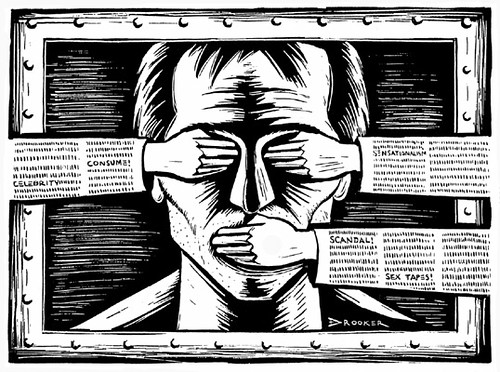Art Censorship is a Slippery Slope

Art censorship has been a salient debate for centuries. Deciding what qualifies as art versus what is ‘obscene’ is an argument with infinitely many opinions as evidence. School is a prime example, where censorship is required for Skyline’s Literary Magazine, and nudity and cursing are outlawed. Sarah Adler, the head editor of the Literary Magazine, and a talented artist/author stated, “I feel very strongly that cursing and nudity do not lower the integrity of the art. Part of learning technical visual art skills involves learning to draw or paint nude figures.”
Most argue that art censorship could result in a conservative view of art, limiting the ability to create, or to share difficult but vital messages. Art is not consistently something that is easy to stomach, and many people share the opinion that what makes art so special is its ability to warrant a reaction from an audience, which gives room for growth for both the creator and the admirer. Adler stated, “ Successfully conveyed messages were all composed by risk takers (Kahlo, Bouche, and Manet come to mind), so why are we teaching today’s young artists to do the opposite?”
There is an argument to be made that art censorship can even be dangerous. Many people feel that censorship is a violation of people’s freedom of expression. Even so, the school is justified in outlawing ‘obscenity’ under the time, place, and manner clause in Article I, Section 4, Clause 1 of the constitution. Nevertheless, just because the justification is legal does not mean that it is morally correct. Emily Young, an 11th grader who is currently part of the Literary Magazine and a published author stated “Labeling the human body as obscene can lead to real problems, especially because it results in media objectification of the body.” The fact that the body is viewed as obscene in the first place hints at the idea that the human body has been made to be something strictly sexual. Adler added, “Furthermore, in some cases, nudity celebrates the body, and is not designed with provocation in mind.” Restricting the idea of the body can cause very dark yet real problems, as Young stated, “Especially in a school full of teenage girls…” While it’s possible that censorship in the school is not always a direct cause of these issues, it’s very plausible that it may indirectly lead to the growth of these unhealthy thoughts in teenagers, and therefore throughout society, limiting change. The school valuing its reputation over awareness can seem unethical in relation to the potential consequences of censorship.
However, censorship might be helpful in the case of the institution, especially in a school setting. Art can be triggering and offensive, for which a school does not want to take the blame. Complaints would fall on the shoulders of the school and they could get in trouble. Deeming what is ‘obscene’ when it comes to art can be difficult, so it’s often easier to outlaw it altogether and avoid the risk. Yet, this then denies the artist the right to create and share in a space that should feel safe and welcoming. The school being self-protective in place of open-minded can be frustrating. As Adler said, “There is a fine line between protecting our students, and stepping into the artist’s space.”




